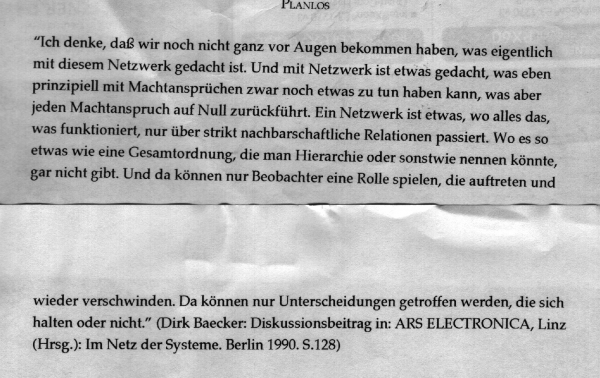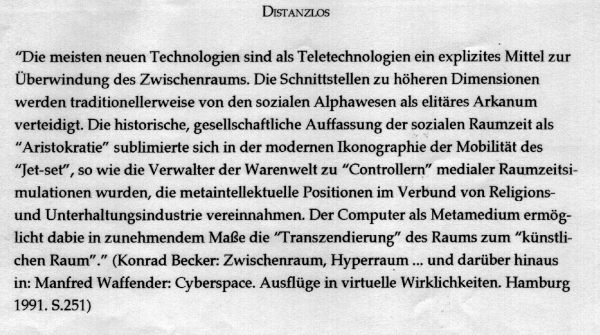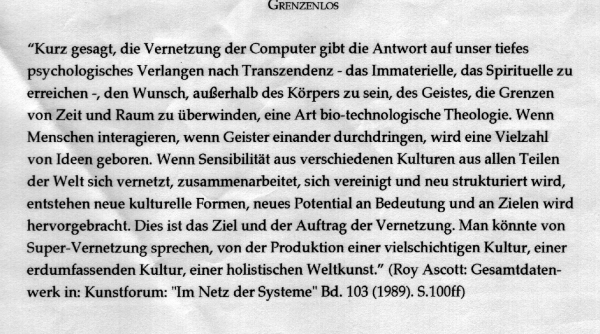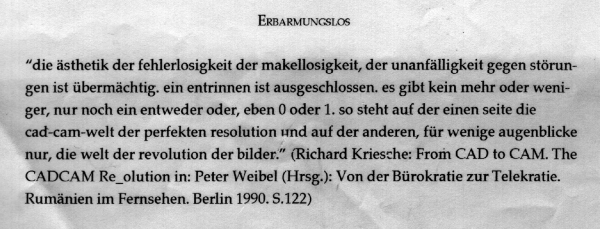Telepräsenz (PhÜD)
Inhaltsverzeichnis
- 1 Phantasien
- 2 Mediated Presence
- 2.1 The hype surrounding tele-presence deserves to be taken seriously.
- 2.2 We cannot afford current, easy explanations of tele-presence.
- 2.3 Our web of belief is under stress. Tele-presence calls for a re-examination of some basic concepts in epistemology.
- 2.4 Presence refers both to a mode of time and to a spatial quality. This link-up is under serious stress and should be used with care.
Phantasien
Mediated Presence
The hype surrounding tele-presence deserves to be taken seriously.
Captions like Telepresence: A Technology Transcending Time and Space or Telepresence: live, interactive, look where you want video on the Internet evoke flights of metaphysical phantasy together with more robust reflexes, familiar from e-commerce.
William J. Mitchell has noted with respect to the term cyberspace: It's a figure of speech that has emerged to cover a gap in our language.
- Telepresence is the art of enabling social proximity despite geographical or temporal distances through the integration of computers, audio-visual, and tele-communicative technologies. [1]
Spatial distance and temporal duration seem indeed to have vanished in the age of global, inter-active telecommunication. It might be objected that networked computers have obviously neither abolished space nor time. True enough, but this objection marks a fallback position without facing the challenge.
We cannot afford current, easy explanations of tele-presence.
One way to see the problem is to observe that we cannot make sense of the puzzlement we are faced with without a working distinction between proximity and distance. Paul Virilio complains that:
- "closer to what is far away than to what is just beside us, we are becoming progressively detached from ourselves."
There is no way to comprehend the complaint but to master the ordinary use of closeness. It has to be presupposed and supplemented with the additional twist suggested by the author. Imagine someone lacking any understanding of closeness: she will not profit by being told that newly available techniques are bringing distant events close to her. We need a concurrent mastery of tele-distance to be able to distinguish between the physical environment and those peculiar impressions we want to classify as close by, yet coming from afar. And we have to keep this separate from the close distance a phenomenologist might want to describe, e.g. the tension arising between persons keeping away from each other in an elevator.
The reason for the confusion often encountered in promotional talk about tele-presence is quite simple. Certain concepts such as left and right or true and false work in pairs, hence the occasional temptation to overstress one component. A notorious example is Baudrillard's universal simulation. Such conceptual extravaganzas almost inevitably lead into dead ends. As soon as it is recognized that deception only makes sense vis a vis knowledge the pendulum swings back: If there is no knowledge, there is no deception either. The dialectics between proximity and distance is a case in point. If we take the abolition of distance and duration as anything but shop talk from media journalists we embark upon a journey that can only end in philosophical embarrassment.
Our web of belief is under stress. Tele-presence calls for a re-examination of some basic concepts in epistemology.
Human perception is regarded as an essential ingredient in the acquisition of knowledge. Humans are sentient organisms, interacting with their environment in space and time, according to their capacities of apperception. It is trivially true that sensual input into the nervous system has to be triggered by stimulation arising within the vicinity of the receiving entity. Anti-metaphysical empirical philosophy, in due course, established sensory affection as a prerequisite of the epistemological process.
Causal chains are, however, not restricted to the neighborhood. A person can be affected by nuclear radiation or by the depletion of the earth' ozone shield. The scope of technologically mediated impingement upon the human subject has been spectacularly enlarged in the preceeding century, just think of electricity, wireless communication and computer networks. Our familiar epistemological scenario has been developed to model the cognitive process accompanying the lightening of a candle, but it is seriously overtaxed in dealing with a light switch.
The characteristic ingredient in any epistemological account is the use of signs. Semiotic dimensions are orthogonal to causal dependencies. Perceiving a word or a picture is not just a case of submitting to a physical input. The recognition of an actress in a newspaper, to pick an example, is peculiarly exempt from her physical whereabouts. The workings of human cognition have usually been discussed within certain semiotic frameworks, the most prominent tools of mediation being concepts or sentences. Such bearers of information content seem to occupy a realm very different from electrical currents running though a wire. Still, in a way that's ancient history. One important presumption underlying the classical setup has become obsolete.
Old signs were pretty static: spoken words, texts, pictures. Their presence to the senses was an all or nothing affair. A meaningful utterance has to be heard by someone, sharing the speaker's location. A given text had to be perceived within a narrowly defined environment. There simply was no option of a text being presented via causal mechanisms from the opposite end of the world in real time.
A dramatic change has, however, occured on the level of technological mediation: contemporary machinery allows us to significantly enhance the causal underpinnings of sign systems. It has become impossible to base knowledge claims exclusively on neighbourhood perception. A live report on TV does not fit into the pattern of the testimony of the senses. When a reporter addresses her audience via a screen we assume a causal chain leading far beyond the living room and giving credibility to her sentences. Classical epistemology distinguishes between sensual affections and conceptual activity. It does not provide a place for cognitive content transmitted by instant tele-mediation.



